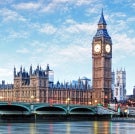Had Labor won with a bigger majority than Tony Blair, Keir Starmer would have been hailed as a colossus. He will deserve to be. No matter how lucky he is, or how much the Conservative Party appears to be led by the opposition’s secret agents, the Labor leader has positioned himself well and not messed around.
It is surprising – to me, anyway – that some uncertainty about the possible outcome of the current election is running from a solid Labor majority to what Grant Shapps, defense secretary, called “supermajority”.
Much of the debate among pollsters in the remaining 19 days of the campaign will be less about how to predict people’s votes, but how to calculate how votes will translate into seats. You can feed the current polls into various models to produce anything from a Labor majority of 144 to one of 336.
I suspect the consensus view will be narrow at the lower end of this range, although as Nigel Farage’s Tory-wrecking drama unfolds, it may be slightly more advanced. In this case, Blair’s post-war record of a majority of 179 is likely to be broken.
There will be articles and books later written about the inside story of how the election was won. Morgan McSweeney, Labour’s campaign manager, will be justly praised for seeing the way forward for Starmer as leader even though the party would have lost five years ago.
Starmer himself will be a case study in how a centre-left party can rebuild an electoral coalition of working-class patriots and middle-class liberals and take advantage of divisions on the right.
His reign will be an amazing and self-sufficient success: a euphoric beginning for the virtues of integrity, service and trying to make people’s lives better. Imagine the happy and shiny faces of Labor MPs, more than half of them newly elected, making up two-thirds of the new House of Commons.
If 1997 was any guide, many Labor skeptics before the election, who complained that they were no different from the Tories, would be swept away by the euphoria of democratic catharsis. After the “change” election, more people remember voting for a new government than actually do. As Blair did, Starmer will enter an imperial phase.
However, before we are all swept away, it is necessary to heed the warning voice. James Kanagasooriam, the political analyst who identified the much-maligned “red wall” before the last election, now says: “Labour is building a monumental sandcastle.”
He said many people were wrong in 2019 to think that Boris Johnson had built a lasting coalition, built on the foundations of Brexit, making inroads into Labour’s working-class base while retaining Tory support in the middle class. But the coalition is “wide and shaky”, Kanagasooriam said.
Since he coined the term “red wall”, it has been used to mean almost the opposite of what it meant. He identified a number of seats in the north of England and the Midlands that should have been more Tory than, by demographics and home ownership. They are places that voted Labor out of cultural inertia, and they are ripe for the taking by an effective Tory campaign. The fall of the Tories was predictable – and not a mysterious, fundamental change.
“We are not spending time thinking about the interim and transactional results of 2019,” Kanagasooriam said. Johnson “borrowed” the voice of those who were ambivalent about politics. As for Brexit, he said, it is also mistaken as an eternal realignment: “People also did it with Brexit. Only after the 2016 vote, 10-15 percent of people changed sides. This should be a sign of the impermanence of politics.
The divisions in Johnson’s coalition were reflected in the MPs elected at the time, Kanagasooriam said. “Without delivery and economic growth, the tide suddenly falls.”
The same, he thinks, could happen in Labour: “With pressure from the green left on foreign policy and climate change, the liberals on taxes and business, the Reformers on immigration and the Conservatives – finally – on leadership. The campaign with the Union Jack says that The time for change will be six weeks. That’s it.
I think it’s true. Public opinion is more volatile than ever; the Labor government was less well-prepared for office than Blair; and will inherit public finances damaged in times of economic stagnation. It is possible that the Conservative opposition will wander the stage, but as I mentioned last week, the Labor Party will present its own opposition and Angela Rayner will be able to put herself on top.
Let’s admire the Starmer imperial sandcastle in all its glory while we can, before the next big wave washes over and knocks it down.





